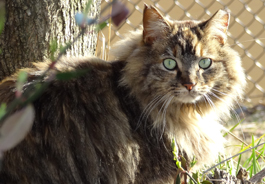For Community Cats, A Change Is Gonna Come
|
|
If [euthanizing community cats is] not helping, it won’t hurt to stop. And in stopping, we can open the door to better ways to protect all human and animal members of our communities. |
Seriously? Just stop euthanizing healthy cats?
You might be thinking that sounds a little too easy. You might also be wondering, “If shelters stop euthanizing cats, won’t communities soon be overwhelmed by a feline population boom? Won’t birds and wildlife be decimated by a sudden superabundance of cats? Won’t the cats suffer and starve?”
I get it. I believed all those things when I was the one out there picking up and euthanizing cats, and these are questions that continue to arise. The answers lie in recognizing the limits of what we are currently accomplishing through shelter intake and euthanasia.
The strongest evidence, interestingly, comes from the very same science often used to decry trap-neuter-return (TNR) programs. While sterilization unarguably benefits individual cats and relieves nuisance concerns, statistical models tell us that 75 percent or more of a cat population needs to be altered to have any overall impact. Detractors of TNR argue that this level of sterilization is rarely attained, and argue for euthanasia as the logical alternative. However, the same statistical models predict that at least 50 percent of cats need to be euthanized to have any impact. So overall, neither approach will be effective unless a sufficient proportion of cats is reached.
The gap in most communities between reality and the level of euthanasia required for population control is staggering. In “The impact of free-ranging domestic cats on wildlife of the United States,” the study that triggered the latest round of controversy over cat predation, the authors’ calculations are based on an estimate of 30-80 million free-roaming unowned cats in the U.S. Currently it’s estimated that around two million cats are being euthanized nationally each year. To reach the 50 percent threshold, then, across the coun- try we would need to euthanize 8-20 times as many cats as we are now. Would communities stand for—much less pay for—such a dramatic increase in cat killings?
We are clearly not euthanizing enough community cats to make even a negligible impact on the number of cats in the community or their impact on wildlife, community health, or feline overpopulation. If it’s not helping, it won’t hurt to stop. And in stopping, we can open the door to better ways to protect all human and animal members of our communities.
What About the Cats?

Krista Rakovan/The HSUS
As shelter professionals and animal lovers, the welfare of cats is naturally of paramount concern. We hate to think of them out on the streets, hungry, coping with weather extremes, predation, cars, and all the other threats that confront free-roaming animals. However, data from shelters and TNR clinics reveals that the vast majority of stray and unowned cats are in good health, suggesting that these resourceful creatures have worked out some source of food and shelter. Several studies have documented survival rates for these cats at rates far higher than that of other small carnivores—and greatly exceeding the odds of survival in a shelter.
Of course, like any living being, cats are subject to hazards, illness, and eventually, the infirmities of old age and death. However, cats are the only species for which it is routinely argued that a certain death today is preferable, for the cat’s own good, to a possible hazard in the future.
So what now? Acknowledging the failures of a system in which so much has been invested may be initially discouraging, but it opens the door to consideration of new possibilities. Knowing that euthanasia of healthy cats neither controls feline populations nor protects individual cats, there is freedom in realizing how little we have to lose. With this in mind, there are two increasingly popular options to consider: sterilizing and returning cats to their habitats (shelter-neuter-return), or, as a last resort, limiting intake when spay-neuter-return is not an option. Over the last few decades, TNR has become well-accepted. In these programs, cats are typically trapped from their community habitat, brought to a spay/neuter clinic, then released at the original trap site. Regardless of the impact on overall feline population size, sterilization and vaccination of individual cats is clearly preferable to allowing those same cats to continue breeding unchecked.
However, the notion long persisted that once admitted to a shelter, the option of sterilization and return was no longer a reasonable one. This may have been out of concern that citizens bringing stray cats to shelters would be vexed to see them reappear a few days later, albeit minus some reproductive parts and an ear tip. But the progress we’ve made in sheltering over the last decades has been accompanied by a vast shift in the public’s attitude toward pets. A recent poll found that more than three-quarters of Americans now believe that only sick and dangerous animals should be euthanized at shelters, and a great majority also believe that community cats should be left in place if the alternative is euthanasia. This gives us not just the freedom, but a strong mandate, to find nonlethal alternatives for healthy cats brought to the shelter.
Recognizing this, more and more shelters are implementing shelter-neuter-return programs (aka SNR) to manage healthy stray cats that would otherwise be euthanized, either because they are unsocialized or because there are simply more cats entering than can be placed into adoptive homes. As in traditional TNR programs, cats are vaccinated, sterilized, and returned to the location where they were found; the only difference is the brief stop at the shelter. Spectacular success has been reported for SNR programs, extending even beyond the dramatic reduction in euthanasia these programs achieve. Getting SNR cats in and out of the shelter quickly frees up time and space for other cats awaiting homes. Although SNR programs— like traditional TNR programs and euthanasia—may not impact feline population size overall, by definition they target those cats that are most likely to cause concern or annoyance to people. Perhaps that’s why SNR programs have led to surprisingly large declines in shelter intake, as well as a decrease in the number of cats found dead on the roadways.
